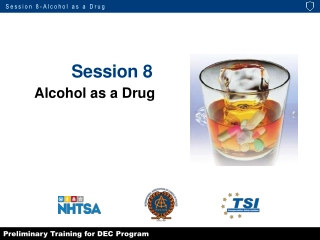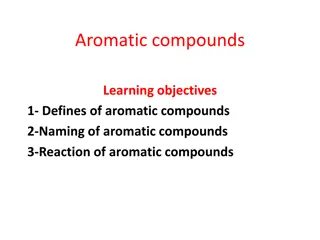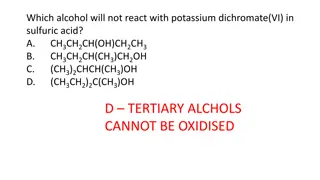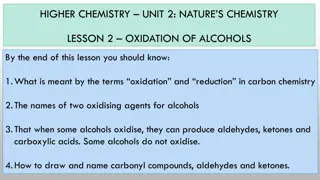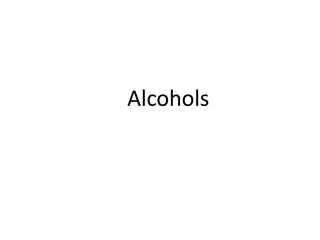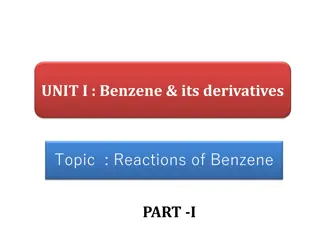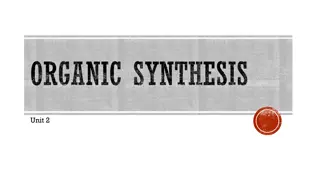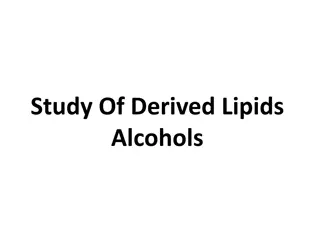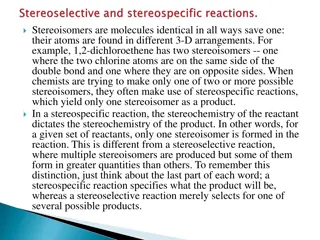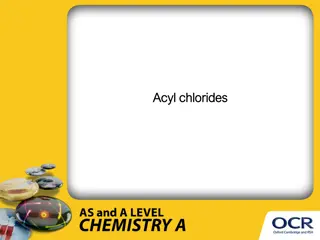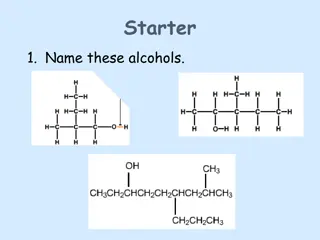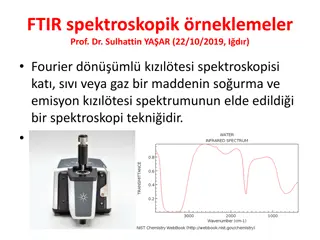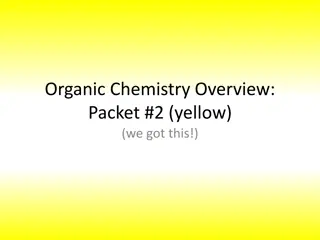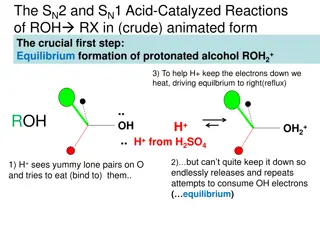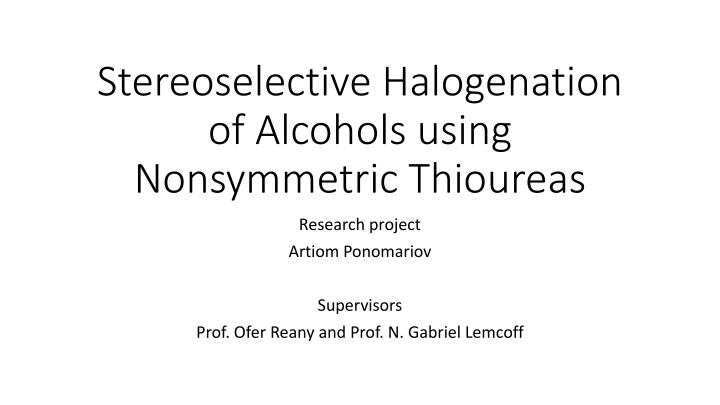
Stereoselective Halogenation of Alcohols Using Nonsymmetric Thioureas
Exploring the stereoselective halogenation of alcohols using nonsymmetric thioureas as catalysts to control the reaction mechanism and influence the outcome. This research project delves into the industrial significance, environmental benefits, and novel methods in organic synthesis for halogenating alcohols, providing an alternative source for halocarbons with reduced pollution impact.
Uploaded on | 0 Views
Download Presentation

Please find below an Image/Link to download the presentation.
The content on the website is provided AS IS for your information and personal use only. It may not be sold, licensed, or shared on other websites without obtaining consent from the author. If you encounter any issues during the download, it is possible that the publisher has removed the file from their server.
You are allowed to download the files provided on this website for personal or commercial use, subject to the condition that they are used lawfully. All files are the property of their respective owners.
The content on the website is provided AS IS for your information and personal use only. It may not be sold, licensed, or shared on other websites without obtaining consent from the author.
E N D
Presentation Transcript
Stereoselective Halogenation of Alcohols using Nonsymmetric Thioureas Research project Artiom Ponomariov Supervisors Prof. Ofer Reany and Prof. N. Gabriel Lemcoff
Introduction The industrial usefulness of alkyl halides Common uses include flame retardants where halides eliminate free radicals Halocarbons offer a safe cheap refrigerant while having a low boiling point allowing good heat absorption Beneficial chemical properties of the C-X bond The nature of the halide as an excellent leaving group opens diverse synthetic possibilities. Polarizability of the halides increases the electrophilicity of the carbon atom. Source: 1. Brominated flame retardants and their metabolites, 2008, Utrecht University. 2. R410A, sold under the trademarked Puron.
Introduction Today s environmental problem of manufacturing alkyl halides from petrochemicals contributes to the green house effect, acidic rains and biomass depletion from the soil Halogenation of naturally occurring alcohols provides an alternative source for halocarbons without the pollution involved in petrochemicals. Source: Adsorbable organic halogens in contaminated water environment: A review of sources and removal technologies, 2021, Journal of Cleaner Production.
Background Classical methods of alcohol halogenation The SNx reaction - the substituted group is affected depending on the number of substituents on the -carbon The Appel reaction conversion of an alcohol to alkyl halide using triphenylphospine and a halide source Source: Atom Economy, Nagwa.
Background A new method was discovered - dimethyl thiourea mediated halogenation of alcohols Dimethyl thiourea converts alcohols into organic halides using stoichiometric amounts of thiourea derivatives and NXS (X= Br, Cl) as the halogen source Using this method under ambient conditions it was possible to halogenate primary, secondary and tertiary alcohols, while maintaining atomic efficiency by recovering the succinimide by-product, i.e the halogen source. Source: Thiourea-Mediated Halogenation of Alcohols, 2020, Journal of Organic Chemistry.
Research question Is it possible to influence the halogenation mechanism to control the stereoselectivity of the reaction by using asymmetric thioureas? Source: Thiourea-Mediated Halogenation of Alcohols, 2020, Journal of Organic Chemistry.
Methodology We will use different thioureas with increasing side group bulkiness to examine if there is a retention or inversion of configuration on the product We will also test different cyclical alcohols with ortho, para and meta substituents to determine if steric hindrance plays a role in the reaction mechanism.
Results - Halogenation of (-)-Menthol Testing (-)-menthol using NBS and thioureas with increasing bulk side group (marked R) produced the desired product as the main product in the mixture In addition to the desired product, we discovered multiple brominations on the molecule The influence of steric effect on yield in bromination of (-)-menthol Due to the high number of products with similar polarity there was no option to explore stereoselectivity using TLC and silica column separation Thiourea side groups reduce desired product yield as shown in the graph, measuring our desired product yield 80 Desired Product (%) 61 60 52 46 40 20 0 Methyl 1-Benzyl 1-Adamanthanyl Substituent type
Results Testing 3-cis- and 4-cis\trans-methyl cyclohexanol using NBS and thioureas with increasing bulk side group (marked R) produced the desired product as the lesser product in the mixture In addition to the desired product, we discovered multiple brominations on the molecule Larger substituents on thiourea resulted in decreased bromination, same as with menthol. The position of methyl group on the cyclohexyl ring did not affect the outcome yield of the desired product. The influence of steric effect on yield in bromination of 3-methyl cyclohexanol 25 23 20 Product B (%) 17 16 15 15 13 13 11 10 10 8 7 7 6 5 0 Methyl 1-Propyl Substituent type 1-Benzyl 1-Adamanthanyl Cis-3 Linear (Cis-3) Cis-4 Linear (Cis-4) Trans-4 Linear (Trans-4)
Findings Thiourea side group bulkiness decreased reaction efficiency in all reactions NBS serves as an oxidant while performing the reaction using wise addition we observed no oxidation in our products. DMTU Gaussian behavior is observed in (-)-menthol The ratio of product to DMTU to NBS is paramount for the reaction to move forward in an efficient manner Abundanc e T IC: AP33 4H .D \ data.ms 120000 3.417 110000 100000 90000 80000 70000 5.634 60000 50000 5.733 40000 4.170 30000 4.122 20000 10000 3.00 4.00 5.00 6.00 7.00 8.00 9.00 10.00 11.00 12.00 13.00 14.00 15.00 16.00 T ime--> Product Ratio (%) Product Ratio (%) Product Ratio (%) at 2.5 eq. NBS with different DMTU equiv. at 0.3 eq. DMTU with varied NBS eq. at 2.0 eq. NBS with varied DMTU eq. 65.0 14.00 57.5 60.0 12.00 80.0 72.4 57.0 70.0 61.1 55.0 10.00 57.5 Product Yield Product Yield 60.0 Product Yield 50.0 8.00 50.0 45.0 6.00 40.0 30.0 40.0 4.00 20.0 34.0 35.0 2.00 10.0 0.0 30.0 0.00 0.3 0.45 0.6 1.5 2 2.5 0.2 0.4 0.6 0.8 1 DMTU equivalent NBS Equivalent DMTU equivalent
Conclusions Further optimization of the reaction is possible until an adequate yield is achieved through adjustment of the reactant : NBS : DMTU ratio Premixing the reactant with DMTU and using wise addition of NBS shows a promising solution to remove oxidation products Due to the multiple by-products in the reaction mixture from the bromination on top of our desired product, TLC & column separation methods have no use until better yield is achieved and oxidation products are eliminated 6 carbon cyclical compounds with the OH group attached to the ring share similar product results but with varying yields. The heavily substituted (-)-menthol showed across all tests a greater yield then the less substituted x-methyl-cyclohexanol (x=2,3,4).
Further tests are required Optimizing the (-)-menthol reaction by adjusting the NBS:DMTU ratio represents a promising step towards utilizing cyclical reactants for DMTU mediated halogenation NBS addition in fractions over a set amount of time showed no oxidation products in the reaction, testing with different starting materials and an optimized NBS:DMTU ratio should yield better results for the single halogenation reaction we are after. After optimization and removal of the oxidation products, it should be possible to isolate the desired product to run NMR analysis for stereoselectivity ratio determination.

